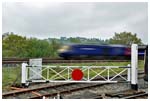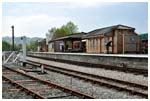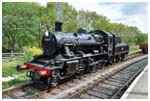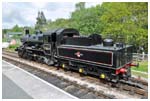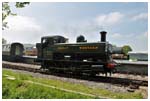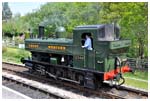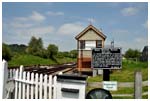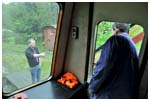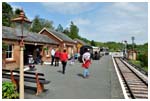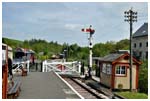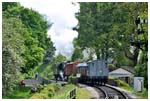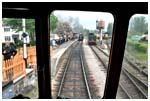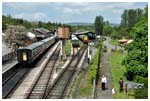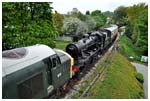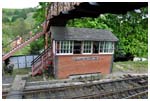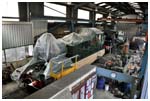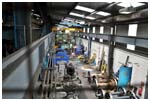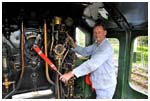The South Devon Railway
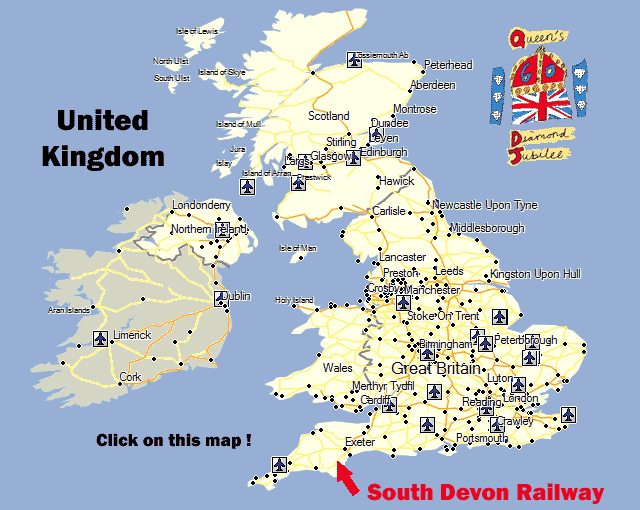
 Introduction Introduction
 The South Devon Railway connects the towns of Totnes and Buckfastleigh in the county of Devon located in the southwest of England. The line parallels the River Dart through lush green and forested country for a distance of about seven miles. For those who wish to visit this heritage railway National Rail has a station located in Totnes served by First Great Western and Cross Country Trains. There is a walking path east from National Rail's Totnes station northeast to a pedestrian bridge over the River Dart that connects to the South Devon Railway station, a distance of about a half mile. The South Devon Railway connects the towns of Totnes and Buckfastleigh in the county of Devon located in the southwest of England. The line parallels the River Dart through lush green and forested country for a distance of about seven miles. For those who wish to visit this heritage railway National Rail has a station located in Totnes served by First Great Western and Cross Country Trains. There is a walking path east from National Rail's Totnes station northeast to a pedestrian bridge over the River Dart that connects to the South Devon Railway station, a distance of about a half mile.
 Timetable Timetable
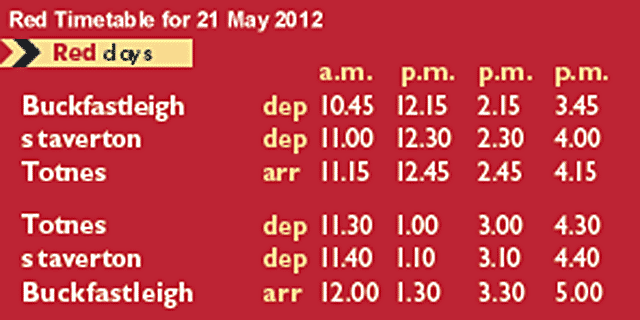
 Along the Way Along the Way
| | 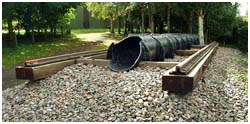
The Atmospheric Railway
Isambard Kingdom Brunel was an engineering genius from the Victorian era in England. By 1844 he was famous for the design of the Clifton Suspension Bridge then being built. His Great Western Railway was complete and the first wooden and iron ribbed paddle steamer, also named Great Western, went into service crossing the Atlantic between Bristol and New York, USA.
During this period an Irish railway operated without locomotives, using air pressure instead to push freight cars along the rails. The new design incorporated a piston housed in an air-tight pipe lying between the rails. Steam engines housed in buildings alongside the track pumped the air out of the section of pipe in front of the piston, and the pressure of the air behind it pushed the piston forward through the pipe. The piston was attached to the floor of the lead railway car by means of a metal plate that projected through a slot in the top of the pipe. This slot presented the railway's designers with their greatest engineering challenge. To maintain a vacuum in front of the piston, the slot had to be sealed, but in a way that would still allow the piston plate to pass easily along it. A rubber seal would have been ideal, but such a thing did not yet exist in 1844, so they used a flap of leather treated with tallow. This new "Atmospheric Railway" achieved a speed of 28 miles per hour and seemed to be capable of steeper gradients than a conventional locomotive could handle. In all it seemed, to Brunel at least, like a very favourable system.
Rail transportation was still a new-fangled idea to most common folk, and not everyone liked the idea of noisy, dirty, locomotives steaming their way through the English countryside on a regular basis. Farmers especially worried that sparks from steam engines might set fire to haystacks or frighten their animals. The Atmospheric Railway, on the other hand, could operate virtually silently and run without smoke-belching, spark-spewing locomotives. Most appealing to Brunel, though, was the Atmospheric Railway's anticipated ability to climb steep grades, exactly the sort of terrain he was facing along the route of his planned South Devon Railway.
Operation on a second atmospheric line showed the shortcomings of the system. The leather seal over the slot in the vacuum pipe caused endless headaches. The leather tended to dry out and become brittle, and when this happened the pipe could not be kept air-tight. The tallow used to keep the leather soft and pliant attracted rats which nibbled on the seals and did even greater damage. Passengers often had to push the cars over the track rather than ride in them.
Additionally, track-side pumping stations used to create a vacuum inside the pipe caused more problems. In order for the trains to run properly, air had to be pumped out of each section of pipe before the train arrived, then allowed back in after the train had passed. But it took several minutes of pumping to create the vacuum, and the stations were not connected by telegraph, so the slightest deviation from a set schedule would bring the system to a halt.
Before Brunel could satisfactorily address these problems, service on the South Devon Railway began in May 1846, using steam locomotives until the atmospheric vacuum tube was completed. More than a year passed before tests of the atmospheric system were scheduled, and several more months before regular service began. Then, within weeks the leather seals on the vacuum pipe began to deteriorate, as they had on the other line.
Brunel remained outwardly confident, declaring that "Notwithstanding numerous difficulties, I think we are in a fair way shortly of overcoming the mechanical defects and of bringing the whole apparatus into regular and efficient, practical working." There seems to have been no real basis for this forecast, however, and by this time even Brunel must have grown desperate as he recognized a failure in the making.
An army of labourers was put to work lubricating and repairing the worn leather seals, but the expense involved put the line into the red, whereas it had earned a tidy sum while it was being worked by steam locomotives. In August of 1848, the last proponent of the Atmospheric Railway finally admitted what had already seemed painfully clear to others, writing, "I cannot consider the result of our experience... such as to induce one to recommend the extension of the system."
After the loss of roughly £500,000, the South Devon Railway was converted back into a conventional locomotive railway line. The great "Atmospheric Caper" was over.
Bruce Heydt.
The complete article appeared in British Heritage Magazine May 2004.
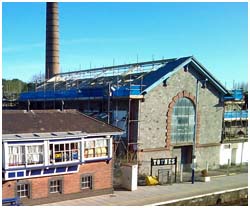 |
As you can see from the timetable it takes just 30 minutes to travel the entire line in just one direction including one stop along the way. If you take your time it's easy to spend an entire day exploring the railway.
Totnes - The South Devon Railway station at Totnes is so close to the National Rail mainline there is a clear view of the passing trains. Sometimes a speeding modern train will whistle a salute when a South Devon steam engine is present. While the South Devon is still physically connected by track to the National Rail mainline, blocked only by one of those typical white British crossing gates with a large red circle in the center, regular South Devon train service does not use the junction. My guess is it would only be used to move visiting equipment on or off South Devon trackage. There are two tracks beside the station but only one platform. The second track provides the ability for steam locomotives to run around their cars after arrival. The platform also holds a water standpipe but I did not see it used during my visit. At the farthest end of the platform there is a small signal box and a pedestrian grade crossing which leads to a cafe and the Totnes Rare Breeds Farm, an added attraction for the children.
Staverton - Located about halfway between Totnes and Buckfastleigh lies Staverton station. This is close to the meeting point where trains may cross each other at the siding just to the west. A small shanty stands next to a grade crossing with the typical hinged white gate that blocks either the road or the track. It's labeled as the Staverton Signal Box and appears to interlock the crossing gates and semaphore signals. Staverton also boasts a cafe, but located in a dedicated railway coach on a dead end siding at the platform. Model railway items and books may also be found here. The small station is of brick construction. Great Western Railway benches adorn the platform.
Buckfastleigh - This is the main terminal for the South Devon Railway. Located here is a substantial station, museum building, restaurant, hobby shop, signal box, locomotive works, with a five track yard, railway office, picnic site, children's playground, car park, miniature railway, and a garden railway which operates some Sundays. While there are two platforms by the station only one is in use. Instead of a water standpipe there is a full water tower to replenish the steam locomotives. The locomotive works is of substantial size and I was surprised to discover a large vertical wheel turning lathe installed at the rear of the shop. Besides maintenance and repair of their own locomotives contract work for other railways also generates income for the South Devon. This entire complex lies immediately next to the A38 Highway but is so shielded by trees that the highway's presence is unnoticeable.
 History History
Today's South Devon Railway originally ran for nine miles from Totnes, where it joins the Plymouth to Exeter mainline, to the ancient stannary town of Ashburton.
There had been several schemes in the mid 1800s to link Buckfastleigh and Ashburton to the fast growing railway network. The mainline from Plymouth to Exeter was being built by the original South Devon Railway. A group of local promoters came up with a plan to link Ashburton to Newton Abbot and in 1848 a Bill for a ten and a half mile branch received Royal Assent. The great Isambard Kingdom Brunel was asked to be the engineer for the line. But with the economy in recession, the plan was dropped.
Eventually another scheme, also to be built to Brunel's broad gauge of 7 feet and 1/4 inch, along the river Dart linking up with the South Devon Railway at Totnes was agreed upon and the line opened on 1 May 1872 as the Buckfastleigh, Totnes, and South Devon Railway. Originally the line was not planned to link with Ashburton.
Operated by the original South Devon Railway, this company was taken over by the Great Western Railway in 1876. The line, along with all the GWR's broad gauge lines, was converted to George Stephenson's narrow or standard gauge (4 feet 8 1/2 inches) over one weekend in May of 1892, a remarkable undertaking involving a massive workforce. Brunel was an incredibly gifted engineer. Had his broad gauge won the day then, today our railways would be faster and the trains would have a greater capacity.
The line's history is a quiet one and it is a sobering thought that the Ashburton branch never made a profit. Goods traffic, mainly coal, wool, cider, and agricultural items, was the lifeblood of the line.
Nationalisation came in 1948 and the line became part of the Western Region of British Railways.
With the coming of the motor car, profits rapidly declined until 3 Nov 1958 when the last passenger train ran, before even Dr. Beeching came on the scene. Freight continued until 7 Sep 1962.
In that year, the local press revealed that a group of businessmen was planning to reopen the line as a steam operated branch line and a commercial company, the Dart Valley Light Railway Limited was born. On 2 Oct 1965, the first rolling stock arrived: GWR locomotives 4555, 3205, and four BR(W) auto trailers.
The first passenger trains ran on the Dart Valley Railway on 5 Apr 1969, hauled by GWR pannier tank locomotive 6412, the official opening, undertaken by no less than Dr. Beeching, followed on 21 May 1969. Sadly, the last two miles of the line to Ashburton were never operated and in 1971, a year short of the line's centenary, the line was severed to make way for the widening of the A38 Highway and the beautiful Brunel station at Ashburton lost its trains.
In 1989, the Dart Valley Railway Company announced that the line was uneconomic and decided to find another operator or close it. The volunteers who had been involved with operating the line realised this was now their chance to form a company to take over the railway and run it as a registered charity. Fortunately there was a registered charity already based on the line, Dumbleton Hall Locomotive Limited, restoring GWR number 4920, "Dumbleton Hall". Its Articles of Association allowed it to run a railway so it took over the lease of the Buckfastleigh branch on 1 Jan 1991. The charity was renamed the South Devon Railway Trust and the railway was renamed the South Devon Railway, the name of the first company to run trains over the line. The volunteer supporting body was similarly renamed the South Devon Railway Association. The first train under SDR operation ran on 29 Mar 1991 with BR(W) pannier tank locomotive 1638 and a rake of former BR coaches, all hired from the Dart Valley company.
Since then the line has expanded enormously, building a loop at Staverton to enable two train running, completing the station buildings at Totnes, expanding facilities at Buckfastleigh, carrying out major civil engineering works on the line, undertaking major re-signalling, including the re-erection of two historic GWR signal boxes, developing, rebuilding, and maintaining a fleet of historic rolling stock, establishing a flourishing engineering business, launching a share issue to purchase the line and, importantly, attracting more and more visitors.
In 2000, the SDR started negotiations to purchase the freehold of the line from the DVR for £1.15 million, the money being raised through a share issue, loans, donations, and revenue. In 2002, the DVR granted the SDR a 199 lease on condition of a new Transport and Works Order being granted to the SDR (a legal requirement), which would grant the final transfer of the freehold title from the DVR to the SDR for the payment of a nominal £1.
In 2007, the line carried over 100,000 passengers for the first time under SDR operation and was named Heritage Railway of the Year and in 2009 celebrated the 40th anniversary of the line's reopening.
On 8 Feb 2010, the last step of the protracted Transport and Works Order process was at last completed, the SDR paid the nominal £1 and became masters of their own destiny.
11 Jul 2012 - This history shamelessly stolen from the South Devon web site.
 Folder Folder
A folder published for the 2012 season is displayed below.
Click on it to view a larger image and the contents.
 South Devon Steam Locomotives South Devon Steam Locomotives
| Number | Name | Wheel Arrangement | Built | Builder | | | | | | | | 1369 | | 0-6-0PT * | 1934 | GWR | | 1420 | | 0-4-2T | 1933 | GWR | | 3205 | | 0-6-0 | 1946 | GWR | | 2873 | | 2-8-0 | 1919 | GWR | | 3803 | | 2-8-0 | 1939 | GWR | | 4920 | Dumbleton Hall | 4-6-0 | 1928 | GWR | | 5526 | | 2-6-2T | 1928 | GWR | | 5786 | | 0-6-0PT * | 1929 | GWR | | 6412 | | 0-6-0PT * | 1934 | GWR |
* PT - Pannier tank.
 News Articles News Articles
26 Dec 1864 - Accident on South Devon Railway
12 Feb 2001 - South Devon Makes Tracks for Railway Freehold
14 Mar 2008 - Brunel Pumping Station Saved from Demolition
11 Oct 2010 - Devon Steam Railway Brings Repair Firm In-House
2 Jan 2011 - South Devon Steam Railway's Passenger Number Record
25 Apr 2011 - South Devon Steam Train in Emergency Stop to Save Lamb
1 Jan 2012 - South Devon Railway Reports Third Record Season
21 Jun 2012 - Celebrations Fit for a Queen
 Slam Door Carriages Slam Door Carriages
Unlike North American passenger equipment British heritage passenger coaches have multiple doors that may be opened by a rider. Of sturdy design they can take a pretty strong slam to close, hence the name, slam door coaches.
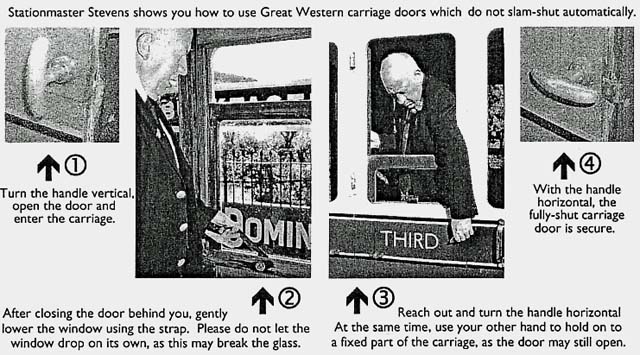
 Bibliography Bibliography
 The South Devon Railway The South Devon Railway
Don Bishop
2009
144 pages hardcover
150 photos
Halsgrove Railway Series
£14.99
 Past and Present the South Devon Railway Past and Present the South Devon Railway
John Broadribb
2012
128 pages softcover
250 photos
Silver Link publisher
£20.00
 The South Devon Railway The South Devon Railway
R.H. Gregory
1982
128 pages paperback
The Oakwood Press
£14.95
 Associated Web Sites Associated Web Sites
South Devon Railway
South Devon Railway Association
South Devon Railway Engineering Ltd.
South Devon Diesel Traction Ltd.
South Devon Railway Signalling
South Devon Railway Road Services
South Devon Miniature Railway
Didcot Railway Center
Network Rail

| Vancouver Island
British Columbia
Canada
|
|

